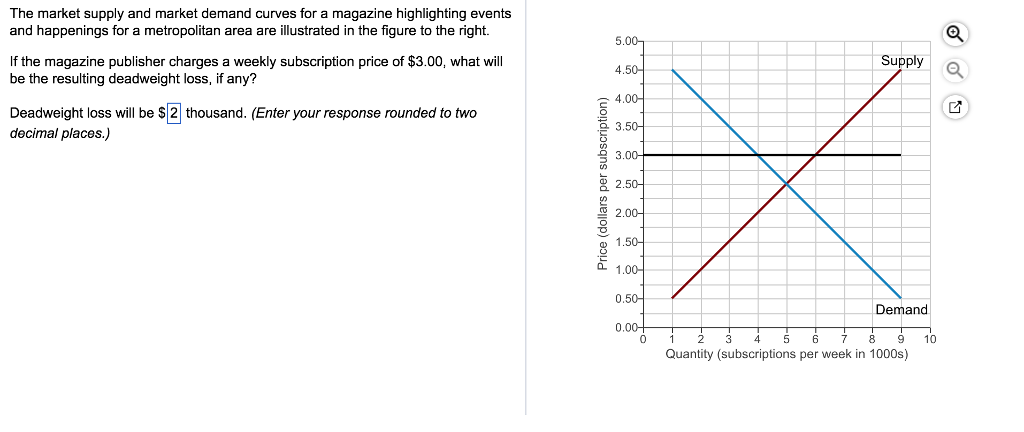The market supply and market demand curves for a magazine highlighting events and happenings for a metropolitan area are illustrated in the figure to the right 5.00 4.50- 4.00 If the magazine publisher charges a weekly subscription price of $3.00, what will be the resulting deadweight loss, if any? Supplya Deadweight loss will be $2 thousand. (Enter your response rounded to two decimal places.) 3.50- 3.00 2.50 2.00- 1.50 1.00 0.50 8 CO Demand 0 1 2 3 4 5 6 789 10 Quantity (subscriptions per week in 1000s)
The market supply and market demand curves for a magazine highlighting events and happenings for a metropolitan area are illustrated in the figure to the right 5.00 4.50- 4.00 If the magazine publisher charges a weekly subscription price of $3.00, what will be the resulting deadweight loss, if any? Supplya Deadweight loss will be $2 thousand. (Enter your response rounded to two decimal places.) 3.50- 3.00 2.50 2.00- 1.50 1.00 0.50 8 CO Demand 0 1 2 3 4 5 6 789 10 Quantity (subscriptions per week in 1000s)
Chapter8: Market Failure
Section: Chapter Questions
Problem 2P: Draw a standard supply and demand diagram for televisions, and indicate the equilibrium price and...
Related questions
Question
Please help with this

Transcribed Image Text:The market supply and market demand curves for a magazine highlighting events
and happenings for a metropolitan area are illustrated in the figure to the right
5.00
4.50-
4.00
If the magazine publisher charges a weekly subscription price of $3.00, what will
be the resulting deadweight loss, if any?
Supplya
Deadweight loss will be $2 thousand. (Enter your response rounded to two
decimal places.)
3.50-
3.00
2.50
2.00-
1.50
1.00
0.50
8
CO
Demand
0 1 2 3 4 5 6 789 10
Quantity (subscriptions per week in 1000s)
Expert Solution
This question has been solved!
Explore an expertly crafted, step-by-step solution for a thorough understanding of key concepts.
This is a popular solution!
Trending now
This is a popular solution!
Step by step
Solved in 3 steps with 2 images

Knowledge Booster
Learn more about
Need a deep-dive on the concept behind this application? Look no further. Learn more about this topic, economics and related others by exploring similar questions and additional content below.Recommended textbooks for you

Exploring Economics
Economics
ISBN:
9781544336329
Author:
Robert L. Sexton
Publisher:
SAGE Publications, Inc

Exploring Economics
Economics
ISBN:
9781544336329
Author:
Robert L. Sexton
Publisher:
SAGE Publications, Inc